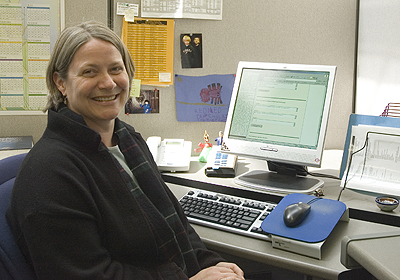Berkeleyan
 |
Barbara Boster summarizes Berkeley stories in the press - whether she spots them in The New York Times or People.(Deborah Stalford photo) |
Reflecting Berkeley from the outside in
Frequently the focus of media coverage, the campus keeps track of who's paying attention with its own digital clipping service
![]()
| 16 March 2006
For a sense of what the campus feels its internal and external audiences need to know, there's no better indicator than Berkeley's online NewsCenter (newscenter.berkeley.edu). To get a bead on the university's impact on the world, Berkeley in the News, a daily compendium of stories reporting on campus research and personages, provides a reflection from the outside in.
Each weekday, Barbara Boster, the Public Affairs staffer who publishes Berkeley in the News, selects stories from top national newspapers (New York Times, Washington Post, Wall Street Journal, Los Angeles Times, and USA Today) as well as most Bay Area papers (San Francisco Chronicle, San Jose Mercury News, Oakland Tribune, and Contra Costa Times) and a variety of other sources. When she finds interesting campus-related stories, often quoting Berkeley faculty as issues experts or reporting on research or events on campus - "anything from news about the a capella singers at Sather Gate to robotic flies reproducing in campus labs," she says - she assesses whether they merit inclusion, then edits an excerpt of each article, so that its relevance to Berkeley readers is clear. Those synopses, along with links to the full stories, make up Berkeley in the News, which Boster posts as a page on the NewsCenter and copies to an e-mail subscription list.
While some of the stories included in Berkeley in the News may not mention the campus or its people directly, they may still be of interest to campus readers, says Boster, because they are hot topics in higher education. She lists military recruiting, financial aid, community-college recruitment, and affirmative action as examples. Articles portraying the university in a negative light - such as policy controversies or questionable student behavior - are also included, since they too are part of the day's news. On the other hand, routine coverage of sports, performances, and alumni newsmakers are not part of the report.
Occasionally, quirky stories that appear out of left field get their moment in the spotlight. One such example was engineering undergrad William Hung's 2004 appearance on American Idol: The dubiously talented aspiring singer bore his dismissal by program judge Simon Cowell with such equanimity that he attracted widespread media coverage (duly tracked by Boster), not to mention winning a recording contract. Another offbeat story surfaced last fall, when Michael Manga, a professor of earth and planetary science, glowed hotter than the lava flow he studies after being named as one of People magazine's "sexiest men alive."
The two-minute briefing
When Boster, who recently earned an M.L.I.S. from San Jose State, joined Public Affairs in 1998 (she'd previously worked as an information manager at a San Francisco advertising agency), she set to work on a rather dated clipping system. This involved scanning stacks of newspapers for Berkeley mentions; cutting, pasting, and photocopying the stories; then walking the packets over to the offices of the chancellor and his cabinet, as well as to her colleagues in Public Affairs. Within a few years this system evolved, coming to rely on the Internet for collection, e-mail for distribution, and, finally, web posting to reach a broader audience.
Marie Felde, director of the Media Relations unit in Public Affairs, regularly hears from people on campus who find Berkeley in the News useful for preparing for the day ahead. "The last thing you want to do is walk into a meeting and be the only one who doesn't know about the day's big story," she says. "By scanning Berkeley in the News for a few minutes each day, you'll be extremely well-informed." Researchers in far-flung locations have told Felde that the weekday updates help them feel like they're in touch with the campus.
Last year Boster developed a searchable archive of Berkeley in the News articles, not only for long-term reference purposes but as a tool for judging the impact of efforts to publicize campus news. The tracking effort also helps Public Affairs evaluate the overall tone of Berkeley's press coverage, which, she says, "is overwhelmingly positive and politically moderate."
The campus's go-to gurus
Boster also keeps tabs on which faculty members journalists cite most as experts. Bruce Cain, professor of political science and director of the Institute of Governmental Studies, is widely quoted on government and political science; "he seems to be in every reporter's Rolodex," she says. Harley Shaiken, professor of education and geography and director of the Center for Latin American Studies, is a labor expert to whom journalists turn during labor crises, such as layoffs at General Motors and Ford, and whom they consulted for the labor angle in the state's 2005 special election. Robert Bea and Raymond Seed, professors of civil and environmental engineering, have been getting a lot of ink for their work on New Orleans' levees post-Katrina. And Xiao Qiang, a lecturer in journalism, has become the go-to guy for articles on online censorship in China.
In last year's news analysis, Boster tracked more than 4,100 stories about Berkeley - "a snapshot of the campus's ultimately unquantifiable coverage," she says. Observes Felde: "While the total numbers are important and even impressive, Media Relations' goal is not just to get the numbers but to assist in placing stories that help people understand the impact the University of California at Berkeley has."
Okay, but what about those numbers? Felde mentions that last year 265 Berkeley-related articles appeared in The New York Times, while National Public Radio produced hundreds of stories with a campus connection for their airwaves. That's noteworthy national exposure no matter how you slice the metrics.
Read Berkeley in the News daily at www.berkeley.edu/news/in_news, or sign up for an e-mail subscription at www.berkeley.edu/news/in_news/subscribe.html.

